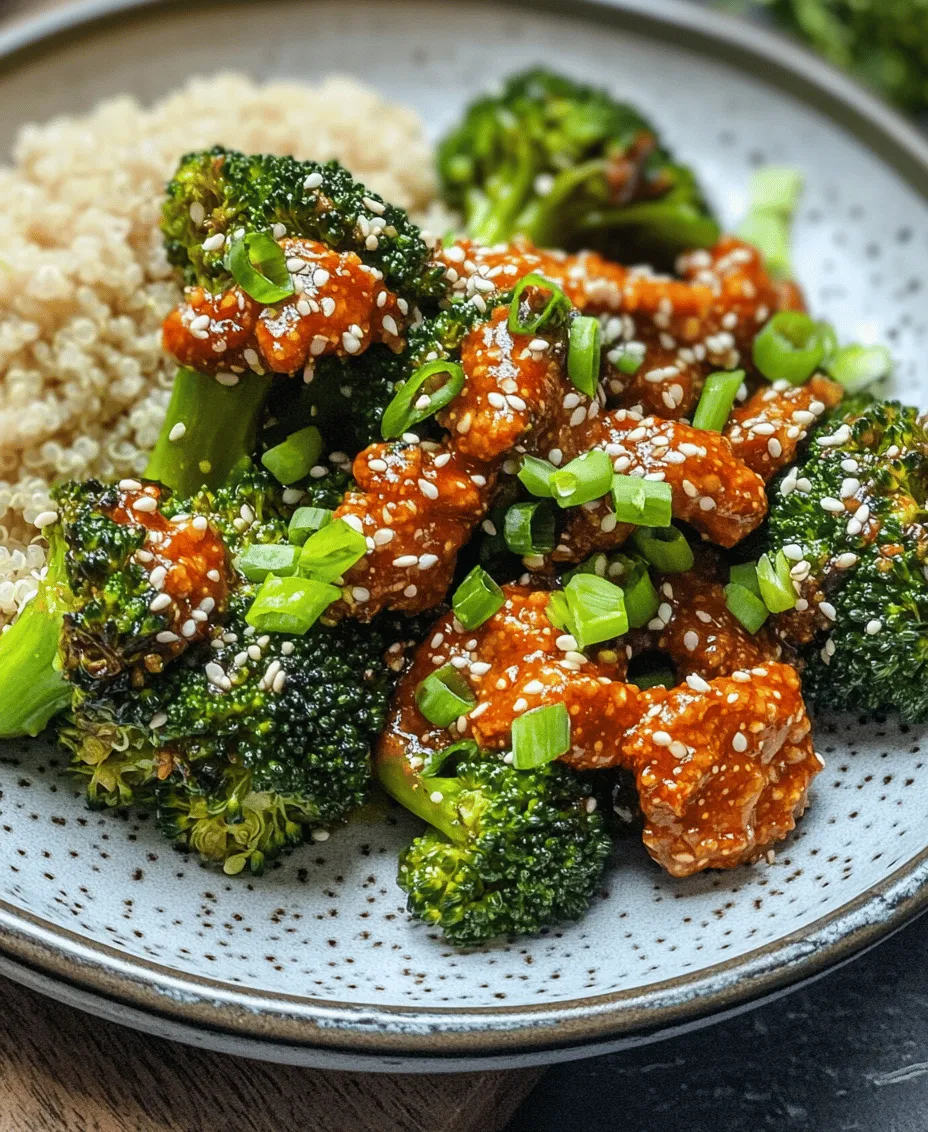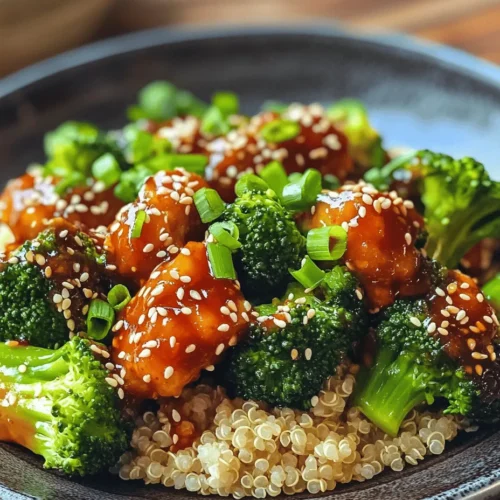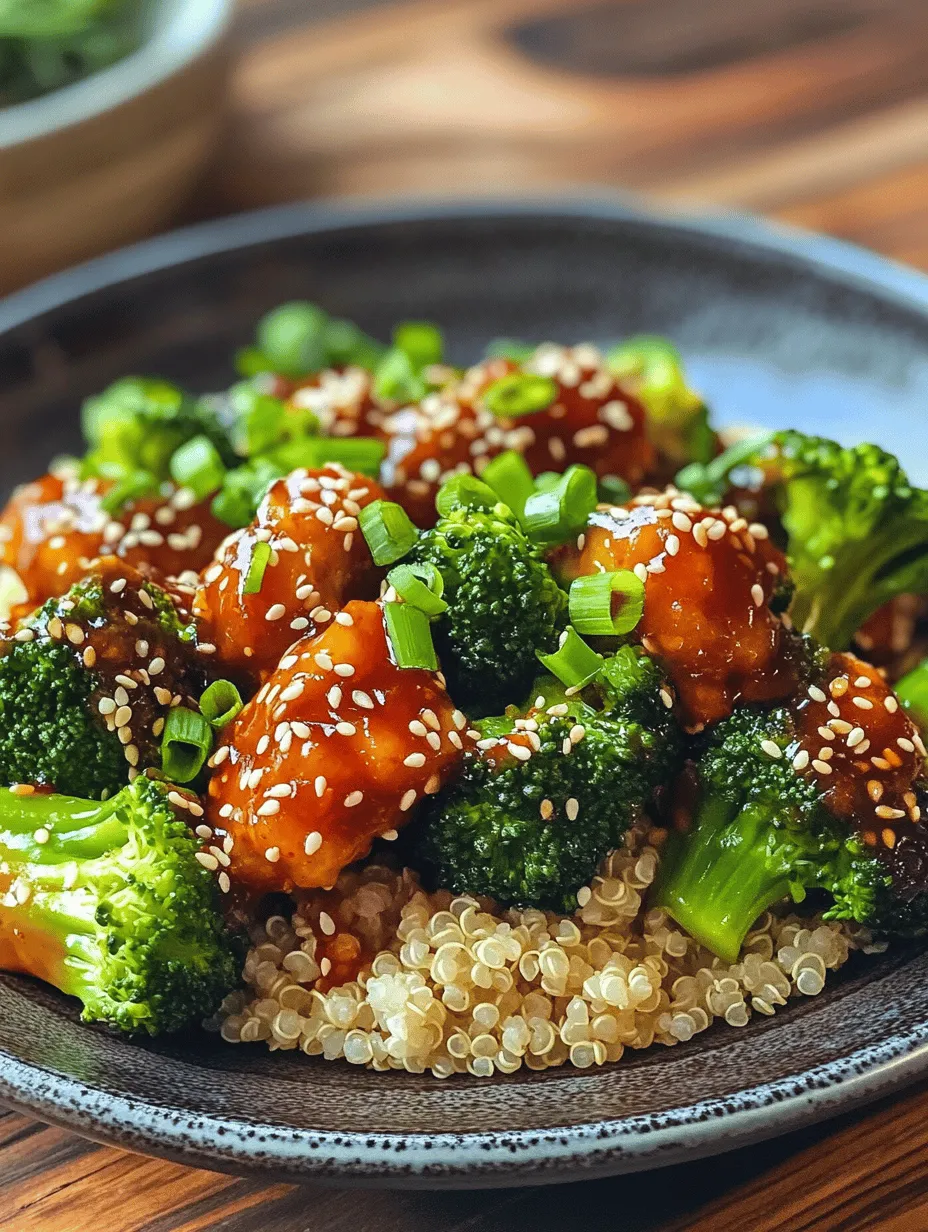Introduction
In the realm of culinary delights, few dishes can effortlessly combine health benefits with mouthwatering flavors like Spicy Gochujang Broccoli. As Korean cuisine continues to capture the hearts and taste buds of food enthusiasts around the globe, this dish stands out as a true embodiment of the vibrant flavors and textures that define this culinary tradition. The marriage of fresh broccoli with the rich, spicy notes of gochujang creates a dish that is not only simple to prepare but also incredibly satisfying.
The growing popularity of Korean food can be attributed to its bold flavors, innovative combinations, and health-conscious ingredients. As people increasingly seek out dishes that are both nourishing and delicious, Spicy Gochujang Broccoli perfectly fits the bill. Broccoli, often hailed as a nutritional powerhouse, pairs beautifully with the unique flavor profile of gochujang—a fermented chili paste that adds depth and spice to any meal. This recipe is a celebration of both ingredients, showcasing how they can transform a humble vegetable into a delightful dish that can steal the spotlight on any dinner table.
As we embark on this culinary journey, prepare to discover not only the ease of making Spicy Gochujang Broccoli but also the various health benefits that come with it. This dish is not just a treat for the palate; it is a nourishing option that supports a healthy lifestyle. With its simple preparation steps and bold flavors, Spicy Gochujang Broccoli is sure to become a staple in your kitchen.
Understanding the Key Ingredients
Broccoli: A Nutritional Powerhouse
Broccoli is often celebrated as one of the most nutritious vegetables available, making it a staple in countless diets. This cruciferous vegetable is rich in vitamins, minerals, and fiber, contributing to a well-rounded diet. A single serving of broccoli is packed with Vitamin C, Vitamin K, folate, and potassium, all of which are essential for maintaining optimal health.
But the benefits of broccoli extend beyond just its vitamin content. It is also high in dietary fiber, which aids digestion and helps maintain a healthy weight. The presence of antioxidants in broccoli also plays a vital role in neutralizing harmful free radicals in the body, reducing the risk of chronic diseases. In addition, the sulforaphane compound found in broccoli has been linked to anti-cancer properties, making it a smart choice for those looking to boost their health while enjoying a delicious meal.
Gochujang: The Heart of Korean Cooking
At the core of this recipe lies gochujang, a staple in Korean kitchens that has gained international acclaim. This fermented chili paste is made from red chili powder, glutinous rice, fermented soybeans, and salt, resulting in a complex flavor profile that is both spicy and slightly sweet. The origins of gochujang date back centuries in Korea, where it has been a key ingredient in traditional dishes that showcase the country’s culinary heritage.
The unique flavor of gochujang adds depth to a variety of dishes, from stews to marinades, and it is often used to create sauces that enhance the overall taste experience. Beyond its deliciousness, gochujang also offers several health benefits. It contains capsaicin, which is known for its metabolism-boosting properties, and the fermentation process provides beneficial probiotics that support gut health. This makes gochujang not just a flavor enhancer but a nutritious addition to your diet.
Complementary Ingredients
In addition to broccoli and gochujang, several other ingredients play crucial roles in this recipe, enhancing both flavor and nutrition.
– Soy Sauce: A staple in Asian cooking, soy sauce adds a savory umami flavor to the dish. It complements the sweetness of the gochujang and balances the spiciness, creating a well-rounded flavor profile.
– Honey or Maple Syrup: A touch of sweetness is essential to counterbalance the heat from the gochujang. Honey or maple syrup serves this purpose perfectly, adding a layer of complexity to the sauce.
– Sesame Oil: This fragrant oil brings a nutty flavor that elevates the dish. A small amount goes a long way in providing richness and depth to the overall taste.
– Garlic and Ginger: These aromatic ingredients not only enhance the flavor but also contribute to the health benefits of the dish. Garlic is known for its immune-boosting properties, while ginger aids digestion and adds a zesty touch.
Together, these complementary ingredients work harmoniously to create a vibrant and delicious dish that is both satisfying and nutritious.
Step-by-Step Guide to Making Spicy Gochujang Broccoli
Preparing the Broccoli
The first step in crafting Spicy Gochujang Broccoli is preparing the star of the dish: the broccoli. To achieve the perfect texture and vibrant green color, it is essential to blanch the broccoli before sautéing. Blanching involves briefly boiling the broccoli florets in salted water, then quickly plunging them into ice water to halt the cooking process. This technique not only helps maintain the broccoli’s bright color but also ensures that it retains its crispness.
To begin, start by filling a large pot with water and adding a generous pinch of salt. Bring the water to a rolling boil. While waiting for the water to boil, rinse the broccoli thoroughly under cold water to remove any dirt or debris. Cut the broccoli into bite-sized florets, ensuring that they are uniform in size for even cooking.
Once the water is boiling, carefully add the broccoli florets and let them cook for about 2-3 minutes. You want them to be tender yet still crunchy—visual cues for doneness include a bright green color and a slight tenderness when pierced with a fork. After the time is up, quickly transfer the broccoli to an ice bath (a bowl filled with ice and cold water) to stop the cooking process. Allow the broccoli to cool for a few minutes before draining and patting it dry with a clean kitchen towel.
Crafting the Gochujang Sauce
While the broccoli cools, it’s time to prepare the gochujang sauce that will infuse the dish with flavor. This sauce is a blend of sweet, spicy, and savory elements that creates a delicious coating for the broccoli.
In a mixing bowl, combine the gochujang with soy sauce, honey (or maple syrup), sesame oil, minced garlic, and grated ginger. The ratios can be adjusted based on your personal taste preferences; if you prefer a spicier kick, add more gochujang, or if you like it sweeter, increase the amount of honey. Mix the ingredients until well combined, creating a smooth paste. Taste the sauce and adjust the sweetness or spiciness as desired.
For those looking to customize the dish further, consider adding a splash of rice vinegar for a tangy note or a sprinkle of sesame seeds for added texture. This versatile sauce can also be used to marinate proteins or drizzled over rice or noodles, making it a fantastic addition to your culinary repertoire.
Sautéing the Broccoli
With the broccoli prepared and the gochujang sauce ready, it’s time to bring it all together through sautéing. This cooking technique allows the broccoli to absorb the flavors of the sauce while achieving a delightful texture.
In a large skillet or wok, heat a tablespoon of oil over medium-high heat. Once the oil is shimmering, add the blanched broccoli florets. Sauté them for about 2-3 minutes, ensuring they are heated through and start to develop a slight char. This step is essential, as it enhances the flavor and adds a beautiful presentation to the dish.
Next, pour the prepared gochujang sauce over the sautéed broccoli. Toss the florets gently to ensure they are evenly coated with the sauce. Continue to cook for an additional 2-3 minutes, allowing the sauce to caramelize slightly and cling to the broccoli. The timing here is crucial; you want the sauce to enhance the broccoli without overcooking it.
Bringing It All Together
As the broccoli and gochujang sauce meld together, you’ll notice the vibrant colors and enticing aromas filling your kitchen. This final stage of cooking is where the magic happens, as the flavors deepen and the dish comes together beautifully. Once the broccoli is evenly coated and heated through, it’s ready to be served.
Spicy Gochujang Broccoli can be enjoyed on its own as a vegetarian main dish, or it can be served as a side alongside grilled meats, tofu, or rice. The versatility of this dish means it can fit into a variety of meals, making it a perfect choice for weeknight dinners or special occasions.
Stay tuned for the next part of this recipe article where we will delve deeper into tips for achieving the best results and answer common questions about Spicy Gochujang Broccoli.

How to Incorporate the Sauce and Achieve the Desired Consistency
Once you have your gochujang sauce prepared, it’s time to integrate it into your broccoli dish for that perfect balance of flavor and texture. Start by heating a large skillet or wok over medium heat. Add a tablespoon of oil—sesame oil is particularly complementary for this dish, enhancing its Asian flavor profile.
Once the oil is shimmering, add your blanched broccoli florets. Stir-fry them for about 2-3 minutes until they become bright green and slightly tender. This quick cooking preserves their crispness while allowing them to absorb flavors more effectively.
Now, it’s time to introduce your gochujang sauce. Pour it over the broccoli while continuously stirring to ensure that every piece is evenly coated. If you find that the sauce is too thick for your liking, add a splash of water or vegetable broth gradually until you reach your desired consistency. The goal is to have a sauce that clings to the broccoli without being overly runny. Allow the broccoli to cook in the sauce for an additional 2-4 minutes, stirring occasionally. This will allow the gochujang to meld beautifully with the vegetables, intensifying the flavor.
Final Cooking Tips for Best Results
1. Quality Ingredients: Always opt for fresh, high-quality broccoli and authentic gochujang. The latter can make a significant difference in the flavor profile of your dish.
2. Don’t Overcook: The key to great broccoli is to keep it vibrant and slightly crunchy. Overcooking can lead to mushy vegetables that lose their nutrients and appeal.
3. Taste as You Go: Adjust the seasoning at each stage. Depending on your spice tolerance, you may want to add more gochujang for heat or a dash of soy sauce for umami.
4. Use a Lid: If you want the broccoli to cook a little faster while retaining moisture, you can cover the skillet for a minute or two while it cooks in the sauce.
5. Experiment with Textures: If you prefer a little crunch, consider adding some chopped nuts, like peanuts or cashews, towards the end of cooking for an added texture contrast.
Presentation and Serving Suggestions
Garnishing for Appeal
Visual appeal plays a crucial role in how we perceive food. A well-presented dish can elevate the dining experience, making it more enjoyable and inviting. For your Spicy Gochujang Broccoli, consider garnishing with sesame seeds and thinly sliced green onions. The sesame seeds add a delightful crunch, while the green onions introduce a fresh, crisp flavor.
Another option is to drizzle a little more sesame oil or a sprinkle of chili flakes on top before serving, which not only enhances the flavor but also adds a pop of color. Remember, garnishing isn’t just for aesthetics; it also contributes to the overall flavor profile of your dish.
Importance of Visual Presentation in Food
The saying “we eat with our eyes first” holds true, especially in culinary arts. A visually appealing plate can stimulate appetite and enhance the overall dining experience. Incorporating vibrant colors and contrasting textures in your dish can create a feast for the eyes, making it more enticing. When plating your Spicy Gochujang Broccoli, take a moment to arrange it artfully on the plate, making sure the garnishes are well-distributed for maximum visual impact.
Suggestions for Garnishes and Their Flavor Contributions
– Sesame Seeds: These provide a nutty flavor and a slight crunch that complements the softness of the broccoli.
– Chopped Fresh Herbs: Cilantro or parsley can add a refreshing herby note that balances the spiciness of the gochujang.
– Lime Wedges: Serving lime wedges alongside adds a bright acidity that can enhance the overall flavor, allowing diners to customize their experience.
Serving Options
Ideas for Pairing with Rice or Quinoa
Spicy Gochujang Broccoli can stand alone as a side dish or take center stage in a meal. For a wholesome, balanced meal, serve it over a bed of fluffy jasmine rice or nutty quinoa. The grains are excellent at soaking up the sauce, ensuring every bite is packed with flavor.
If you’re looking for a heartier option, consider adding grilled chicken or tofu on top of the broccoli and grains for added protein. This combination provides a robust, satisfying meal that’s perfect for lunch or dinner.
Alternative Serving Suggestions for Different Dietary Preferences
For those following a low-carb diet, consider serving Spicy Gochujang Broccoli over zucchini noodles or cauliflower rice. These alternatives maintain the essence of the dish while catering to dietary needs. If you’re looking for a gluten-free option, ensure your gochujang is certified gluten-free, and serve the dish alongside grilled meats or seafood for a complete meal.
For vegetarians and vegans, this dish is already a perfect fit, but you can also serve it with a side of roasted chickpeas or tempeh for an extra protein boost.
Nutritional Benefits of Spicy Gochujang Broccoli
Breaking Down the Nutritional Content
Spicy Gochujang Broccoli is not just a flavorful dish; it’s also packed with nutrition. Each serving of broccoli provides essential vitamins and minerals, making it a superfood in its own right.
– Caloric Breakdown per Serving: A serving of Spicy Gochujang Broccoli (about one cup) typically contains around 100-150 calories, depending on the amount of oil and sauce used.
– Key Vitamins and Minerals: Broccoli is rich in vitamins C, K, and A, along with folate and fiber. These nutrients contribute to overall health, supporting immune function, and promoting healthy skin and bones.
Health Benefits of Eating Broccoli Regularly
Regularly consuming broccoli can have profound health benefits. This cruciferous vegetable is known for its high levels of antioxidants, which combat oxidative stress in the body. Moreover, broccoli contains sulforaphane, a compound that has been studied for its cancer-fighting properties.
Additionally, the fiber found in broccoli aids digestion, promoting gut health and regularity. Including broccoli in your diet may also assist in weight management due to its low-calorie density and high fiber content, which keeps you feeling full longer.
The Role of Spices in Health
Incorporating spices like gochujang into your meals can also offer health benefits. Gochujang contains chili peppers, which are rich in capsaicin, a compound known for boosting metabolism and potentially aiding weight loss. Furthermore, spicy foods can promote better circulation and may even enhance mood due to the release of endorphins when consumed.
Cultural Significance of Korean Cuisine
Korean Culinary Traditions
Korean cuisine is characterized by its bold flavors and diverse ingredients. Common elements include fermented foods, fresh vegetables, and a variety of spices, with gochujang being a staple ingredient. This red chili paste embodies the essence of Korean cooking, offering both heat and umami in a unique way.
Traditional Korean cooking methods often emphasize grilling, steaming, and stir-frying, which help to retain the nutrients in the ingredients while enhancing their natural flavors. Dishes are often served with an array of banchan (side dishes), creating a vibrant and communal dining experience.
The Role of Gochujang in Traditional Dishes
Gochujang is not only used in Spicy Gochujang Broccoli; it plays a pivotal role in many traditional Korean dishes, including bibimbap and bulgogi. Its versatility allows it to be used in marinades, sauces, and soups, giving a distinctive kick to a wide range of meals. The flavor of gochujang is deeply embedded in Korean culinary culture, representing the balance of sweet, spicy, and savory that defines the cuisine.
How Spicy Gochujang Broccoli Fits In
Spicy Gochujang Broccoli exemplifies how traditional Korean flavors can be adapted into modern dishes. Its preparation highlights the fusion of ingredients and techniques that are becoming increasingly popular globally. This dish reflects broader trends in Korean cuisine, where vibrant flavors and health-conscious ingredients are combined to create meals that are both satisfying and nutritious.
Moreover, this dish appeals not only to those familiar with Korean food but also to a global audience, bridging the gap between cultures through the universal language of flavor. It offers a unique twist on everyday vegetables, encouraging more people to explore and enjoy Korean-inspired dishes.
Conclusion
Spicy Gochujang Broccoli is an exciting dish that showcases the robust flavors and health benefits of Korean cuisine. With its easy preparation and vibrant taste profile, this recipe is perfect for anyone looking to add a little spice to their meals. The nutritional benefits of broccoli and the health-promoting properties of gochujang make this dish not only delicious but also a wise choice for a healthy lifestyle.
Whether you serve it as a side or as the star of your meal, Spicy Gochujang Broccoli is sure to please. We encourage you to explore more Korean-inspired recipes and immerse yourself in the rich flavors and traditions of this remarkable cuisine. Cooking is not just about the food; it’s about the joy of creating and sharing delicious meals with those you love. Enjoy the cooking process, and happy eating!


